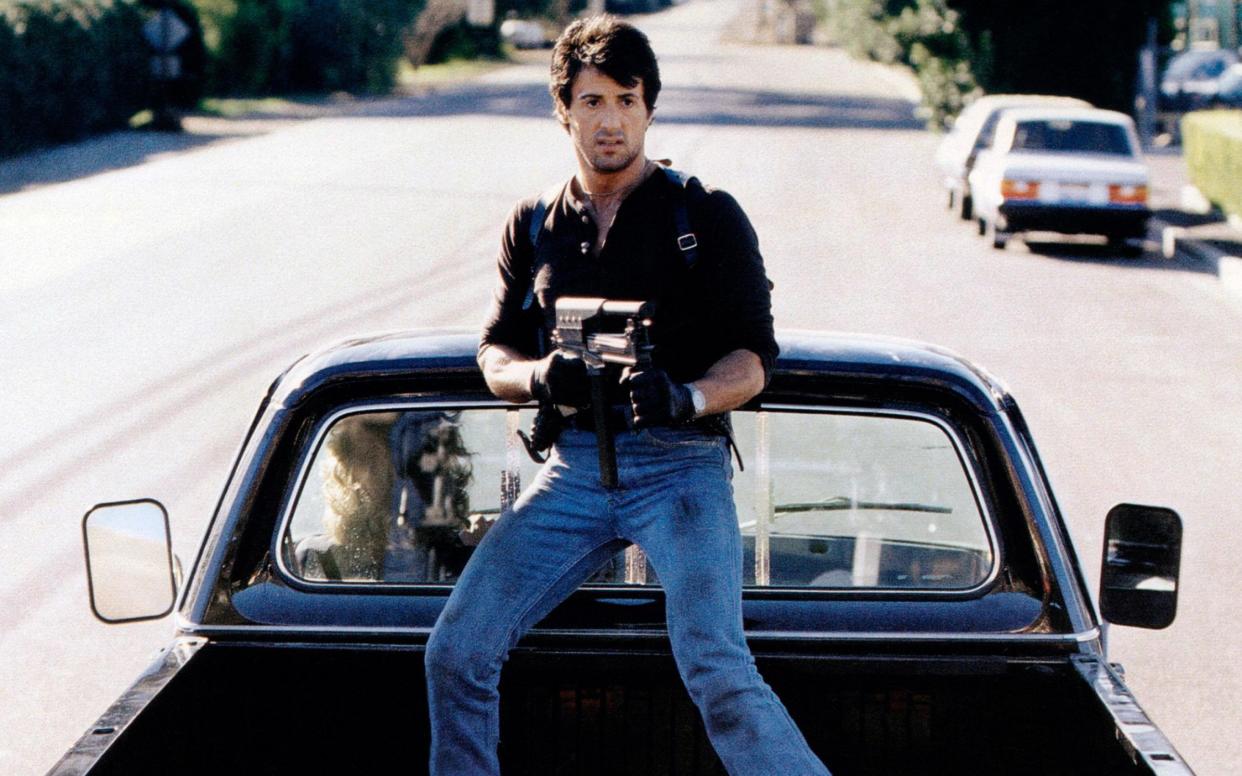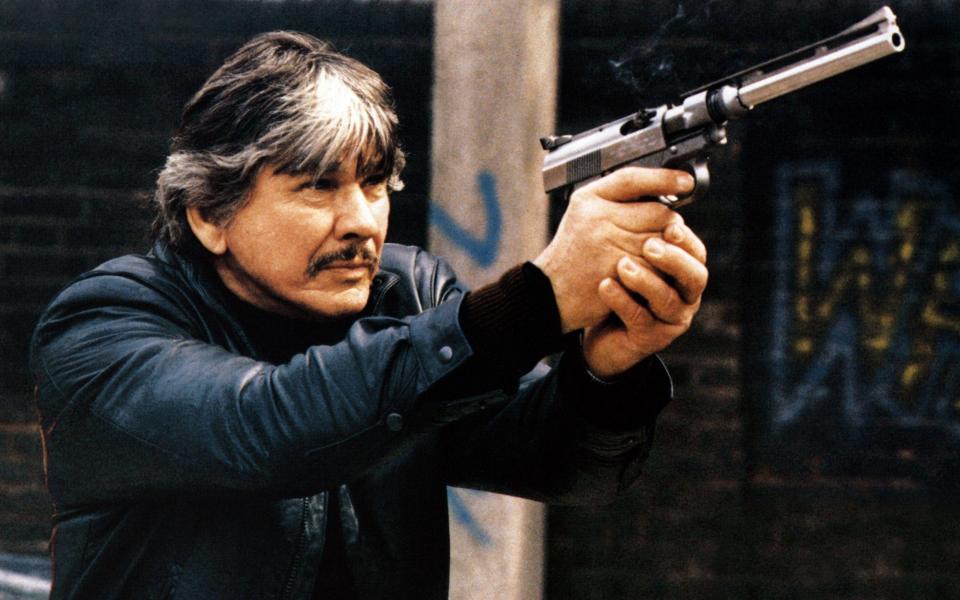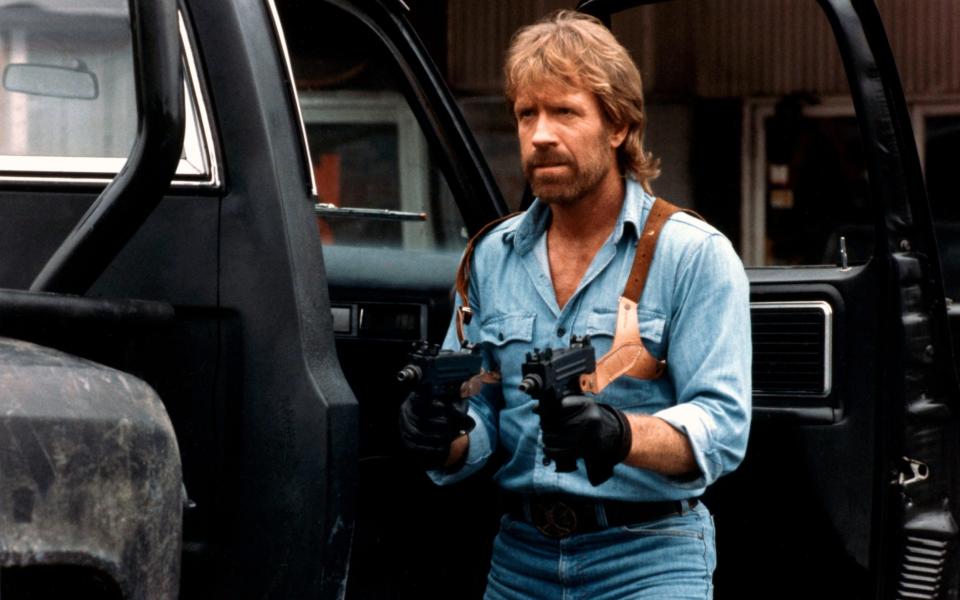Take that, Expendables: the 10 most absurdly violent Eighties action films

As the fourth Expendables film hacks, shoots and stabs its way into cinemas, audiences may be forgiven for feeling a sense of disappointment. Compared to the casts of the other three pictures, which boasted appearances from icons including Arnold Schwarzenegger, Mel Gibson, Harrison Ford and Bruce Willis, the ensemble for this one – ridiculously, and unpronounceably, named Expend4bles – is distinctly more B-list, with the likes of 50 Cent, Megan Fox and Dolph Lundgren supporting the starrier duo of Sylvester Stallone and Jason Statham. Early reviews, predictably, have not been kind.
Fans may be mollified by the knowledge that this one, unlike the third in the series, is R-rated (15 certificate in the UK), but even the BBFC’s advice that it contains “occasional gore including severed limbs, decapitations and eviscerations” is unlikely to satisfy the true aficionado of action cinema, who will dismiss this (and the others) as fundamentally tame.
It is with these blood-hungry viewers in mind that we present a selection of the 10 films that the Expendables series might wish to emulate in their levels of violence, but will never come close to their sheer unhinged brio. Most of these pictures could never be described as “good” in any conventional cinematic sense, but all contain moments that, once seen, are never forgotten.
1. The Exterminator (1980)
James Glickenhaus’s horror-thriller, revolving around a traumatized Vietnam veteran who returns to New York and takes revenge against a gang who have paralysed his army buddy, might be seen as a more violent version of the vigilante picture Death Wish: itself hardly an exercise in tasteful restraint. Glickenhaus commented of The Exterminator’s unrelenting brutality that “television and film had sanitized violence for a long time. Someone points a gun, it goes bang and on the other side of the street some guy goes ‘Aaaaah’ and falls down. But violence is really pretty unpleasant and I thought I had an obligation to portray it that way.”
A noble intention, but it would have helped if he could have cast a lead actor who could act – his star Robert Ginty does a decent impression of a homicidal plank of wood – and if the script had attempted anything other than a glorification of the protagonist’s increasingly deranged actions. Still, over four decades after its release, it remains a jaw-dropping exercise in brutal excess.
Most brutal scene: amidst a great deal of grimness, first place has to go to the scene in which a mob boss is fed into a giant industrial mincer, in some detail.

2. Sudden Impact (1983)
Despite being an Oscar-winning director who has generally made excellent films – albeit with a few notable exceptions – Clint Eastwood has to be allowed an occasional diversion into schlock. The fourth instalment in the Dirty Harry series, in which Harry is sent on the trail of a serial killer who proves to have a righteous motive for her actions, is a fine example of a deeply silly and borderline misogynistic film posing as a far better one. Eastwood directed this picture and cast his then-wife Sondra Locke as the rape victim; the two divorced a few years later. Still, amidst the queasy sexual violence and absurd fates for its villains – one is impaled on a carnival unicorn’s horn – Eastwood, at least, remains as charismatic and watchable a presence as ever.
Most absurd scene: iconic rather than absurd, but this is the Dirty Harry film in which the Eastwood character declares to a robber “Go ahead, make my day” while pointing a Magnum at his face.

3. Savage Streets (1984)
After rising to fame with her indelible performance in The Exorcist, Linda Blair had a more tempestuous Eighties; she was arrested for cocaine possession, posed for Playboy and appeared in such unapologetically dreadful schlock as this teen vigilante exploitation picture, in which she plays Brenda, a young woman who takes bloody vengeance after her deaf-mute sister is raped and her pregnant best friend murdered. The sheer nastiness that leads to Blair’s rampage of revenge makes early scenes almost unwatchable. But the none-more-Eighties fashions and soundtrack, gleeful lack of taste and hilariously dismal dialogue means that this takes its place amongst the most bizarre pictures of the decade.
Most absurd scene: as often in these films, the best is saved for last, when Brenda not only shoots her would-be rapist in the legs with a crossbow, but hisses at him “Too bad you’re not double-jointed, because if you were, you’d be able to bend over and kiss your ass goodbye!”

4. Commando (1985)
Many of Arnie’s films from the Eighties stand the test of time, whether it’s the time-travelling thrills of The Terminator, the epic sweep of Conan the Barbarian or the intensity of Predator. However, his silliest – and therefore most guiltily entertaining – film of the decade is his knowingly ridiculous action picture Commando. From the film’s nonsensical tagline – “Somewhere, somehow, someone’s going to pay” – it is clear that logic and character development are not a priority, but the adventures of Schwarzenegger’s stoic ex-special forces colonel, the marvellously named John Matrix, are executed with all the violent brio that you would hope for. Matrix has a particular penchant for impaling his enemies on otherwise blameless domestic items, and a table leg and steam pipe are both pressed into usage in his one-man mission of righteous destruction. It’s very stupid, and enormous fun should you be in the mood.
Most absurd scene: less the bloodshed and more Matrix’s immortal taunt to a henchman: “Remember, Sully, when I promised to kill you last? I lied!” After the henchman falls to his bloody demise, Arnie quips “I let him go” with suitably deadpan menace.
5. Death Wish 3 (1985)
The first two Death Wish films may not have been classics of cinema, but they at least nodded to an engagement with issues of morality and social justice. By the time that Michael Winner came to make the third picture, he and his star Charles Bronson had abandoned all pretence of seriousness and had turned the continuing exploits of the vigilante Paul Kersey into an ultra-violent farce. It begins with the Kersey character (whose family have all been killed in the previous pictures) returning from a year’s freelance vigilantism throughout America, and only grows more absurd from there. The emphasis on sexual violence – a hallmark of Winner’s downmarket brand of action cinema – leaves a decidedly nasty taste, but Bronson is as gruffly charismatic as ever and the film’s finale has to be seen to be believed.
Most absurd scene: the shoot-’em-up climax, in which Kersey and his allies are shown dispatching apparently endless villains popping up from derelict buildings, before Kersey kills the main antagonist with a rocket launcher.

6. Invasion U.S.A (1985)
If Chuck Norris had not existed in the Eighties, it would have been necessary to invent him, as the martial arts expert was so archetypal a figure of the Reaganite right. He made numerous profoundly braindead pictures during the decade, but the most gloriously inane is Invasion U.S.A, in which Norris’s CIA agent Matt Hunter must battle a group of Soviet-backed Cuban refugees, who have infiltrated Miami and created a wave of terror as a result. Norris claimed that he was attempting to draw attention to a genuine social issue that he had read about in (naturally) Reader’s Digest magazine, saying “The movie is not meant to scare people, but to make us aware of a potential problem…we’re trying to make a statement here.” Unfortunately, any genuine attempt at political insight is buried under one-dimensional characterisation, sadistic violence and a performance by Norris that was aptly panned by one critic in the words “an actor whose most evocative facial expression is his beard.”
Most absurd scene: when Hunter finally faces off against the film’s primary villain, the Soviet agent Rostov, he needs more than a mere gun to dispatch such a dastardly evildoer. Just as well, then, that he has a bazooka to hand.

7. Cobra (1986)
Expendables star Sylvester Stallone famously turned down the lead role in Beverly Hills Cop, which was then hastily rewritten around its new star Eddie Murphy. He instead chose to make this ultraviolent police thriller, which weaves in elements of horror films in its level of intensity. Stallone, who also wrote the screenplay and collaborated again with his Rambo director George Pan Cosmatos, is a brooding presence as the unstoppable detective ‘Cobra’ (with the unfathomable Christian name ‘Marion’) who finds himself pitted against a Darwinist cult known as the New World, led by a sadistic serial killer known as the Night Slasher. Obviously indebted to Clint Eastwood’s infinitely superior Dirty Harry, Stallone nonetheless manages to amp up the violence – the film had to be heavily edited to avoid receiving an X rating – while still maintaining his charismatic hard man image. The film’s poster tag line, cited in the picture itself, remains a classic, too: “Crime is a disease. Meet the cure.”
Most absurd scene: Many films of this era liked to see their antagonists die in especially creative ways, and Cobra was no exception; the Night Stalker ends up both impaled on a convenient hook in the film’s steel mill finale, and then burnt alive in a giant furnace.
8. Surf Nazis Must Die (1987)
The exploitation studio Troma never had the faintest intention of making films with any degree of artistic integrity. But even so, their notoriously silly Surf Nazis Must Die comedy-thriller was greeted with particular opprobrium upon its initial release; the legendary critic Roger Ebert walked out of a screening after 30 minutes, citing its immense tastelessness – the central villain is called ‘Adolf’ – as invalidating any reason for it to exist. Subsequently, it has been reassessed by certain discerning viewers as a satire on both Nazi iconography and California surfer culture, but its central revenge plot, in which an elderly woman sets about dispatching the eponymous surfing fascists after they murder her son, contains all the low-brow violence and cheap thrills that its target audience might expect. It also looks incredibly cheap, and was clearly made on a budget that would barely keep its protagonists and antagonists alike in beach attire.
Most absurd scene: it has to be a toss-up between a scene towards the end, when a woman is (unconvincingly) decapitated by a speedboat, and one of cinema’s least erotic sex scenes, intercut with scenes of people surfing.

9. Road House (1989)
Patrick Swayze blew away any reputation he had as a gentle romantic lead in the excellently named Rowdy Herrington’s ridiculously violent thriller. Swayze plays Dalton, an enigmatic ‘cooler’ – essentially an upmarket bouncer – who is hired to manage security at a Missouri bar, and before too long finds himself embroiled with Ben Gazzara’s sinister local tycoon and his minions. The plot makes little sense, and the near-constant stream of inadvertently camp dialogue (“I used to f___ guys like you in prison!”, one henchman declares in a fight) and over-emphasis on Swayze’s muscles suggest that the makers are not entirely taking their film seriously. Still, when it comes to offering bloody and violent thrills, offset with a healthy dose of ridiculousness, this picture – which is now being remade by Doug Liman and starring Jake Gyllenhaal – is at least more watchable than many of the others on this list.
Most absurd scene: it is suggested throughout the film that Dalton once ripped out a man’s throat with his bare hands, and, in the finale, we are treated to a reprise of this ultraviolent party piece.
10. Wanted: Dead or Alive (1989)
After his early work with Paul Verhoeven and his unforgettable appearance in Blade Runner, Rutger Hauer might have expected a stellar career awaited him, which is why it is a disappointment that, by the end of the Eighties, he found himself mired in formulaic pap like the action film Wanted: Dead or Alive. Based on a Steve McQueen television series from the Fifties, Hauer brings a gruff charisma to his bounty hunter character.

But what elevates the picture from purely workmanlike into strangely watchable is the utterly bizarre casting of none other than Kiss’s Gene Simmons as an Islamic terrorist named Malak Al-Rahim, who Hauer’s Nick Randall is asked to track down, only – as is the way of these things – to be double-crossed by his employers. Simmons is hardly Laurence Olivier, but the sheer incongruity of his appearance – at a time when Kiss had not yet been rediscovered – gives this B-movie an invigorating strangeness. Oh, and it’s violent, too.
Most absurd scene: after Randall captures Al-Rahim and delivers him to his treacherous employers, grenade in mouth, he pulls the pin out of the grenade, and audiences are treated to the vision of Simmons’ prosthetic head being detached from his body.


